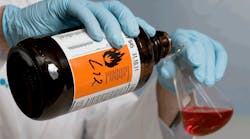New Technology Is Helping Regulators Know Which of the 80,000 Manufactured Chemicals Pose Risks
A team of federal government researchers successfully has tested a new method to more quickly and cheaply collect data that can help define the potential human health risks for more than 80,000 chemicals now in commerce and the environment. The researchers believe it lays the groundwork for far-reaching advances in managing chemical risks in the United States and worldwide.
The new approach, described in the article “Using In Vitro High-Throughput Screening Data for Predicting Benzo[k]Fluoranthene Human Health Hazards” and published in the journal Risk Analysis, will help government regulatory agencies, such as the Environmental Protection Agency, decide which among the thousands of chemicals should receive greater scrutiny first. Priorities would be set on the basis of chemicals’ potential hazardous effects on humans and on their potential to get into human lungs and other organs.
Using rapidly evolving computer-based methods to integrate data and information from many sources, the researchers say, will make it possible to start defining levels at which chemicals might cause harm and then to select those chemicals in the environment that should be more fully assessed. That ability has long been recognized as a critical unmet need.
“In my opinion, this work is starting to lay the foundation that will allow risk assessors and risk managers around the world to couple high-throughput screening tests and adverse outcome pathways for risk assessment,” says Dr. Lyle D. Burgoon of the U.S. Army Engineer Research and Development Center in Research Triangle Park, N.C.
Quantitative high-throughput screening (qHTS) uses robotics and other technological devices that allow researchers to quickly conduct millions of chemical tests. Adverse outcome pathways, or AOPs, trace changes in biological systems that lead to harmful effects.
To assess the usefulness of the qHTS-AOP approach, Burgoon worked with colleagues Ingrid Druwe, Kyle Painter and Erin Yost from the Oak Ridge Institute for Science and Education, who were assigned to the EPA National Center for Environmental Assessment. Their research used the cancer-causing chemical Benzo[k]Fluoranthene to pilot test the promising chemical risk assessment method and was published in the online version of Risk Analysis, a publication of the international Society for Risk Analysis.
The research focused on Benzo[k]Fluoranthene’s putative ability to cause steatosis, a cell disease in which excess fatty molecules build up in cells. It also focused on the chemical’s potential to damage DNA as a result of oxidation, which can cause electron losses associated with some diseases and cancers.
Burgoon says the qHTS-AOP approach especially is critical for the chemicals currently in the environment for which data are lacking. “High-throughput screening provides an avenue to get more data on these chemicals in a shorter amount of time, at an overall lower cost. As scientists generate more data from these high-throughput tests, our approach will allow these data to be integrated together, to create a better sense of what a safe exposure may be.”
Ideally, risk assessors would use qHTS data in combination with reverse dosimetry data and models. Such data are based on levels of chemicals found in biological samples (from human hair, blood, etc.). The samples are used to define chemical levels in the environment that caused the exposures, but data derived from reverse dosimetry are currently insufficient.
Until the gap in reverse dosimetry data can be filled, the qHTS method will allow chemicals to be ranked for regulatory attention. Priorities will depend on which chemicals the qHTS tests find are potentially more harmful relative to other chemicals. Those findings will be paired with real-world data on how much of the chemical is found in air, water, or other places.
“Overall, we feel confident that as more qHTS data become available we will be able to translate these into risk assessment research needs and risk screening assessments,” the authors write in the study. “We are equally confident that transparency can be enhanced over time, as we continue to migrate towards more computationally-efficient, semi-automated methods.”
Risk Analysis: An International Journal is published by the nonprofit Society for Risk Analysis (SRA), an interdisciplinary, scholarly, international society that provides an open forum for those interested in risk analysis.
